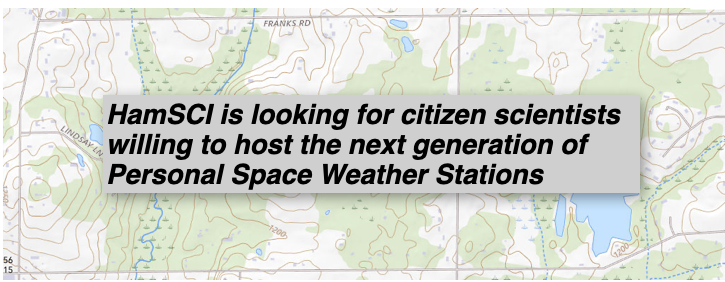HamSCI Searching for Instrumentation Sites and Hosts
Project Goals
The Personal Space Weather Station project aims to create a geographically diverse, multi-instrument network (consisting of 15 to 30 sites) that will make ground-based measurements of the space environment. The observations from this project will not only be useful to the owner of the system, but also aggregated into a central database for space science and space weather research purposes. Much of HamSCI’s research to date has been on the Earth’s ionosphere and magnetosphere, there is a strong desire in the research community, and from the participating institutions (see below), for an expanded network featuring co-located instruments noted below. It is believed this approach will be a ‘first’ in space weather research.
The Plan, and the Need
HamSCI is making plans to deploy multi-instrument Personal Space Weather Stations across the US and possibly into Canada. ‘RF quiet’ sites are needed where the hosts would be willing to install and operate the following:
- RX888/WSPRDaemon/Grape Receiver (GPS disciplined HF SDR receiver, covering 160-6 meters, antenna of host's choosing)
- VLF Receiving System (VLF receiver at ~8kHz, ground mounted active antenna, cabling from the field to a building, Raspberry Pi)
- Ground Magnetometer (Magnetic field detector, buried in PVC pipe, cabling from the field to a building, Raspberry Pi)
Project Status
May, 2024: HamSCI will be approaching various funding agencies (including The National Science Foundation) for DASI (Distributed Array of Scientific Instruments) grants. There is no guarantee that funding will be obtained. The funding request will be more likely to win approval if a reasonable plan, with some site commitments, have been obtained and noted in the grant application(s).
It is expected that grants will cover the costs of the project hardware, thus expenses incurred by hosts should be minimal (but we can’t guarantee that they will be zero). We are asking for a commitment of time and place. HamSCI intends this project to be an example of citizen science at its very best.
Site Selection Criteria (revised 27 Apr)
Long term commitment, 1 year or more
Hamshack or workshop with spare monitors, keyboards, mice, cables, hand tools, etc.
Host (operator) of reasonable technical competence - familiar with simple wire antenna construction and installation, single board computer (Raspberry Pi) software configuration, Ethernet connectivity, outdoor cabling (weatherproofing, protection from animals, mowers, cultivators, etc.)
Stable Internet connection for sending data to the Cloud
Time to participate in virtual meetings with project leaders, other hosts and the general HamSCI community (most HamSCI project teams meet weekly - but that is not a requirement!)
Rural or semi-rural location for both the VLF Rx’s active antenna and the buried Ground Magnetometer (which can be co-located):
Ground Magnetometer Site Considerations
- should be at least 200 ft away from any type of aerial, underground, or structures with power wiring.
- should be at least 200 ft away from any underground ground wire (for example, used to tie an antenna site ground to the main shack ground)
VLF Receiver Site Considerations
- 200 ft separation from above/below ground aerials, wiring, ground wires to a home or other source of mains harmonics (same as magnetometer considerations, see above)
- should be at least 30 ft away from a tree's farthest overhanging branch
- cannot be installed in brush, bushes, or under trees, but tall grasses are acceptable
- should have an earth ground connection at all times
- open fields are usually the best locations if the above conditions could be satisfied
Interested Participant Form
Please complete this form if you are interested in providing a site and hosting the next generation of the Personal Space Weather Station. Doing so will enable the project team to see 'the big picture' and reach out to you with comments, questions, etc.
Supporting Institutions



